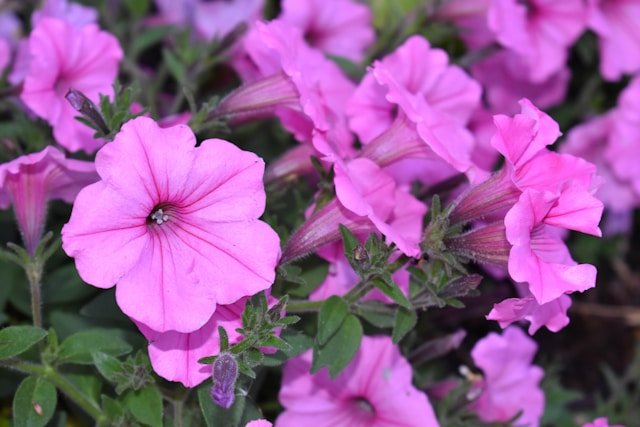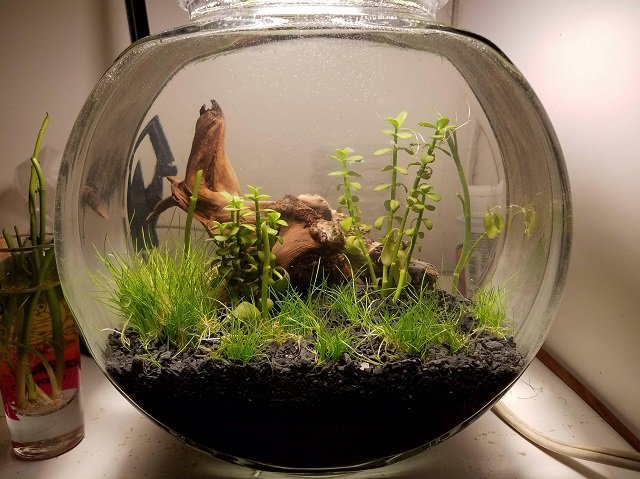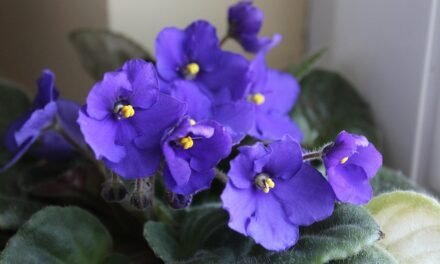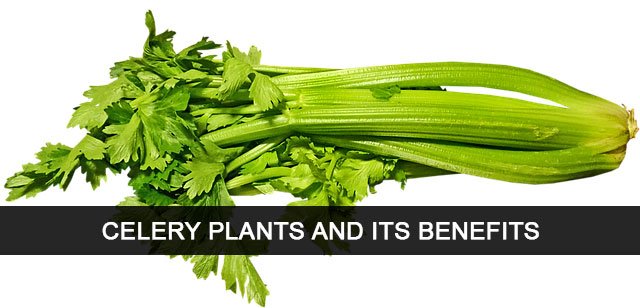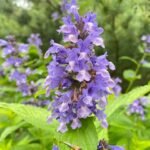Among the spectacular manifestations of landscaping, deep purple vines of these plants truly stand as the moat spellbinding. These flora artworks, having their own lip-smacking shades and eye-catching trails, graciously beautify gardens and nature scenes. From decorative/grown vines to different groundcovers, these plants not only serve aesthetic purpose, but they also deliver functionality making them highly valued green space transformation elements. We are going to take off to the heart of their various characteristics and in doing so combine our botanical tapestry into harmony.
General Features of Vine Purple Leaf Plants:
Striking Foliage:
Without a doubt, the most captivating characteristic of Purple Vine plants would have to be their exceptional foliage. While some species boast sensational deep plum leaves that emit a luxurious effect, others exhibit softer lavender hues, which bring an air of elegance to any environment.
The leaves can be shaped differently ranging from the refined, heart-shaped kind to large ordinary lanceolate ones, exciting the visual sense.
Versatile Growth Habits:
The vine purple leaf plants offer you varieties of growth habits which will surely lend their touch to match your garden preferences. Other have trees used as a support spraying upward vertically or spreading out horizontally in clumps forming plant cover.
Due to their capability to grow everywhere, there is no distinction between indoor or outdoor cultivation environment because be it containers or hanging baskets or garden beds be it indoors or outdoors, they create beautiful flora.
Seasonal Interest:
Vine Purple Leaf plants have a stepwise breathtaking change in appearance with each season displaying a spark of beauty and interest for the watchful eyes. Sensing spring, the wispy and crisp sprouts appear, endowed with hues of light pink and Burgundy, the early messengers of spring’s rebirth.
From the beginning of summer, the trees will go on as they have reached the peak of their splendour and richly covered in leaves and cast as many colors as possible of the shadow of the same kaleidoscope. Every fall’s end is like a final show of autumn before it sleeps. That is, leaves transition into shades of crimson and bronze to cast the landscape in a fitting autumn fresh glitter.
Ecological Benefits:
Vine purple leaf plants, aside from their beautiful lineaments, play a vital role in environmental balance by becoming the domicile for pollinators and other beneficial insects. Their abundant vegetation forms a habitat that many animals use as shelter and sometimes food which in turn leads to biodiversity and allows the ecosystem to thrive.
Besides that, their soil erosion reduction and urban heat island mitigation features make them an essentially green option in landscape practices and thus enable cities to have sustainable and tough landscapes leading to their resilience and vibrancy.
Now, it is time for us to unlock the different varieties of vine purple leaf plants revealing their characteristic traits and the unlimited options they open the way towards the creation of an attractive and tranquil outdoor atmosphere.
Purple Hyacinth Bean (Lablab purpureus):
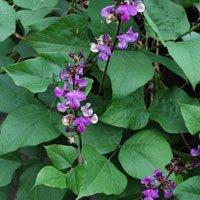
Purple Lablab Bean or Dolichos bean is a stunningly beautiful flowering vine. Its foliage add ornament to the garden, while flowers drip with colour, and finally the pods can be consumed. Starting in Africa, this plant, which is both multifaceted as well as adaptive has slowly come to permeate gardens and landscapes all over the world, leaving a spell in the central nervous system of gardeners due to its beauty and toughness. Besides being an eye-catching addition to outdoor space, this plant’s romantic-looking dark-violet foliage and impressive flowering effort is an enrichment of taste to any region and can also be a valued source of nutrition. Let us now explore its dazzling and seamless side(s) and cathartic as well as frustrating topics, so that we can see it through the eyes of a true lover of plants.
Majestic Features of Purple Hyacinth Bean:
Stunning Foliage:
- The leaves of the Hyacinth Bean variety of Purple are big, dark green-purple, elongated hearts that are placed opposite each other on the stems, producing a stunning effect of a green-purple background.
- Trees that have flaming colors are among the choice planting for gardens landscapers who want to provide garden plots, borders, and trellises with drama and sophistication.
Prolific Flowering:
- Yellow-eyed pansies, one of my all-time favorites, are almost flawless in their ability to revitalize even an ordinary city garden. Blooming below the eye level of a typical pedestrian, these bright flowers stand high enough to freely wave in the wind.
- The pollen offers an indulgence for pollinators, including the bees and butterflies that visit the garden. These insects contribute a significant role in maintaining the variety of life and guaranteeing adequate fruit set of crops.
Ornamental Pods:
- With time the faded blossoms and flowers are replaced by young, thin pods, delicately suspended from the vines above them.
- These pods are purple (nearly) and glossy which is eye-catching to coin a phrase and can be used for culinary purposes.
Fast Growth:
- Means of propagation of Wild Purple Hyacinth Bean is quite fast. It runs through the trellis, fences, and arbors with its vigorous vine in an hour.
- The height of this plant is a beneficial feature that makes it an option that will have your outdoor space in shade and privacy in an instant. You won’t see bare patches of land since it turns the area into a green paradise.
Drought Tolerance:
- Purple Hyacinth Bean that has developed special traits for arid climates, is excellent for water-saving irrigation once established.
- This attribute of drought resistance gives it the low-maintenance characteristic of a perfect water-wise landscaping companion that grows well in harsh climatic conditions with minimal backwash irrigation.
User-Friendly Features of Purple Hyacinth Bean:
Easy Propagation:
- The Purple Hyacinth Bean that can be simply propagated through seeds that germinate at a rapid pace when sown directly into the ground after the last frost.
- The seeds may be created indoors before the last freeze date, so as to kick start the growing season.
Versatile Uses:
- As well as ornamental role, Purple Hyacinth Bean is also considered useful in human diet as it is edible and can be prepared in various ways in the kitchen. The ears in the young plants and seeds are consumable and are used in many different dishes.
- The plant has double-purpose since it can be incorporated into the vegetable garden that has edible landscapes, presenting both beauty and nourishment at a time.
Low Maintenance:
- After being planted firmly, Purple Hyacinth Bean is an easy-care and shows tremendous promise when its conditions are full sun and well-drained soil.
- Watering is the only thing to be done occasionally as pruning the plant to keep the growth in check, cutting off some dead or damaged branches if necessary is all that is required. Hence it’s a perfect fit for busy people who have no time for gardening.
Pest Resistance:
- Purple Hyacinth Bean shows a form of susceptibility (hardiness) to very many of the normal pests and diseases, thereby reducing the requirement and cost of using chemicals as an intervention.
- This characteristic gene continues to make a great contribution to increase the efficiency of the plant, which can endure a high level of performance throughout the growing season.
Seasonal Interest:
- While Purple Hyacinth Bean is already a stunning plant in summertime with a display of flowers and greenery, fall is the time of the year when the plant captivates everyone with its seasonal exploits.
- With the arrival of cooler temperatures, the forestry transforms into a kaleidoscope of fiery hues, from the rich orange to the deepest red, offering one more chance for visual celebrations before the winter comes and the plants enter their sleepy dormancy.
Irritating Features of Purple Hyacinth Bean:
Invasive Tendencies:
- Somewhere in certain regions, this species is considered offenders whenever they intend to exert so hard that they will displace the native plant species.
- In certain locations gardeners who plant Purple Hyacinth Bean must be very careful and monitor the growth of this kind of bean to prevent environmental disruption.
Toxicity Concerns:
- Although its seeds and pods are safe only when cooked, they are still poisonous without cooking unlike other legumes.
- Due to consideration of preparation before consumption is important, make sure they are thoroughly cooked for elimination of the toxins.
Messy Seed Dispersal:
- Pods will be ripe and full when the plants are almost ready for harvest. They might be drying and splitting pods, thus seedling entering the volunteers at random.
- Pods should be regularly discarded as they finish their life cycle. This will reduce self-seeding and the area should maintain a manicured look.
Limited Cold Hardiness:
- Likewise purple Hyacinth Bean is vulnerable to frost and freezing temperature; therefore, it might be alt necessary for gardeners to provide supplementary frost protection or overwinter it indoors is the environment becomes too harsh to endure.
- Growers in the highlands may need to prepare purple beans as an annual or utilize a big pot for easy overwintering.
Allelopathic Effects:
- Some researchers are indicating that the leaves of this plant produce molecules called allelopathic compounds that prevent the growth of nearby plants.
- The may be optimum for culling of the weeds but may also hinder compatible planting and intercropping techniques.
Conclusion:
At last, I would like to underline that Lablab purpureus is a biological miracle, attracting gardeners to their dazzling foliage, large number of applications, and seasonal splendor. While its attribute of invasiveness and inherent detrimental effects are noteworthy, its tremendous benefits more than make up for these otherwise rare occurrences. Be it for the interior or exterior, it is the Purple Hyacinth Bean’s pods and its vine appearance that really take center stage. We may not even remember what the original plant looks like with its second skin in place. Via our deepening understanding of this prominent plant, let’s give it more recognition, and celebrate it for its role in beautifying our outdoor spaces.
Purple Trumpet Vine (Campsis radicans ‘Purpurea’):
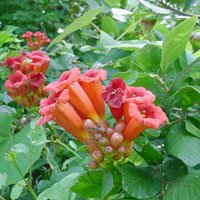
The indistinguishable nature of the Purple Trumpet Vine (Campsis radicans ‘Purpurea’) symbolizes the notable beauty and perseverance connected with the process of climbing vines. This ornamental vine entourages with its waterfalls of the lavish purplish-blue flowers and lush greenery and gives over a touch of delicacy to every garden or landscape. Having been originated from North America, it can tolerate a variety of climatic zones from the temperate climate to the subtropical one. Being widely popular amongst gardeners with its beautiful blooms and dominant growth habit, it can be found in many gardens. Let us enter into the enchanting, thrilling and sometimes infuriating domain of this stunning flora in an effort to appreciate its bewitching beauty and liberate its diversely fascinating traits.
Majestic Features of Purple Trumpet Vine:
Profuse Flowering:
- Purple Trumpet Vine is a trumpet-shaped flower that changes colour from purple to rich purple to make the garden more stunning with an expressive display of the most diverse colours.
- The array of flowers draws pollinators like bees and hummingbirds who increase the richness of organisms in the garden and the beauty of it.
Bold Foliage:
- Polished off with its Purple Trumpet Vine’s extraordinary flowers, it also has thick green leaves dipped with the lighter purple color.
- The green canopy serves as a beneficial decoration for the detailed colors of flowers generating an amazing landscape for the garden.
Vigorous Growth:
- As such a climbing plant with vigorous growth rate, Purple Trumpet Vine grows over trellises, pergolas, and fences with its funnel-shaped blooms.
- It grows really fast, and this is a great pace for creating yard privacy, casting shade and a vertical accent in landscaping.
Long Blooming Season:
- The floral period of Giant Trumpet Vine remains throughout the summer period and lasts from tip to the middle part of the summer period (spring to the beginning of autumn).
- This extended bloom not only keep the level of fragrance and color high all year long but attracts some insect pollinators too.
Adaptable to Various Soils:
- The soil type Adaptation That Purple Trumpet Vine shows to sandy loam soil is very loose, and it can as well be adapted to clay soil as long as it is well-drained.
- It is thanks to its ability to thrive in a broad spectrum of soil types that this plant can be successfully grown in a garden near city areas as well as in private plots on the verge of countryside.
User-Friendly Features of Purple Trumpet Vine:
Low Maintenance:
- Once started, this shrub will grow with little maintenance. It is suitable in bright sunlight with regular watering.
- The needs for pruning are minimal, i.e., to cut down the height and remove dead or damaged branches. Thus, this plant is very easy to cultivate and is also advantageous to novice gardeners.
Easy Propagation:
- Pairing the upcoming panel discussion with local organizations and business development services can help students gain the necessary practical skill to lead and succeed in business.
- Besides, seeds may be harvested from mature pods and planted in the soil in spring. This will help seedlings grow and eventually develop into trees.
Wildlife Attraction:
- The purple-trumpet vine’s nectar-rich flowers becomes a hotspot for butterflies, moths, and honeybees among other beneficial insects.
- Likewise, the project aim is setting as a species friendly plant that makes the natural habitat. As such, it needs to create a perfect environment for the insects and other invertebrates in the garden.
Tolerant of Urban Conditions:
- Purple Trumpet Vine indicates the ability to endure to stressors of urban environment including pollution, compacted soil and showing good adaptability for urban gardens and roadside plantings.
- The greening of urban environments is aided by its ability to grow even within the most difficult conditions, hence increasing the greenery and the beauty of the cities.
Versatile Uses:
- Bush or vine, Purple Trumpet Vine can be trained to climb garden structures vertically. In addition to its decorative value, the vine can be trained on trellises, pergolas, and walls to add more vertical interest to garden structures.
- Besides, this type of plant can be perfect to be used in hanging baskets or container gardening, adding a real spot to florist their house patios and balconies.
Irritating Features of Purple Trumpet Vine:
Invasive Potential:
- In some of the areas, because of the rapid spread of the vine, the vine is considered an invader, out-breezing native species.
- To can gardens be sure that they should be careful of the process of the spreading as well as monitor to prevent ecological damage.
Aggressive Growth:
- Purple Trumpet Vine’s exuberant structure has the potential to cause some pain to manage especially in the gardens that have limited space, and this requires regular pruning of the vine so as to avoid strained areas.
- The weed can easily break out of barrier and spread to other plants and structures. Continuous monitoring would be required to fix that.
Messy Seed Dispersal:
- While the blooms of the Purple Trumpet Vine start to diminish, the seeds begin to form spots that burst, spreading the seeds into the surrounding area.
- Such a self-seed behavior can create a bunch of little volunteer seedlings, You can tidy up the garden anytime any of these seedlings start to interfere with the overall aesthetics of your garden.
Potential for Damage:
- Purple Trumpet Vine, characterized by its strong and woody stems that can get fixed to different surfaces with adhesive pads, is very prone to inflicting damage to materials like walls and fences, which are the most obvious examples
- Periodic pruning and centering play a crucial role in keeping plants strong enough not to get hurt and to ensure the growth within the desired boundaries.
Allergy Concerns:
- A few people can develop pollen and sap allergies from the yellow trumpet vine with effects of inflammation or mild breathing symptoms as a result.
- Due to the inclination of said plants to allergens, it is essential to consider them during the process of choosing for landscapes, preferably in high-volume areas or at places that are commonly visited by individuals who are allergic to those plants.
Conclusion:
Through our discussion, we have seen that the ‘Purpurea’ variation of purple trumpet vine (Campsis radicans ‘Purpurea’) stands out as a beautiful new feature that can bring charm to any garden, with its amazing flowers, its easy handling, and sometimes some troubles. If carefully managed, its invasive characteristics and aggressive growth make it all the more an asset in the garden that offer ornamentation, attraction of wildlife, and adaptability to a range of climate conditions. Gardener through his/her perception can create a habitat dynamics with all its virtues and disadvantages. It is possible to create an amazing ecosystem with a wide range of colors, aromas, and vitality. Come, friends, let us salute our life-long faithful companion that is Purple Trumpet Vine, and let us exploit its boundless potential to the fullest to make our outdoor spaces enchanting for ages.
Purple Bell Vine (Rhodochiton atrosanguineum):
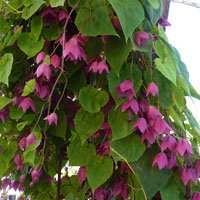
The Purple Bell Vine (Rhodochiton atrosanguineum), which is a real existential treasure for any gardener, remains a botanical wonder of the world due to its mesmerizing bell-shaped flowers and tendril vine growth. The enthralling vine is of Mexican origin, and with both indoor and outdoor plants it dazzles areas with its white pearl flowers and a unique elegance that is truly fascinating. With its trailing tendrils that have the shade of deep purple sprinkles over their blossoms, the Purple Bell Vine grabs attention along with the degree of admiration and astonishment, granting a view of color and charm that is simply outstanding. Let us embark on a journey of discovery; by revealing its towering beauty, intuitive design, and occasionally annoying essence, we shall put to rest the curious allure of this beautiful species.
Majestic Features of Purple Bell Vine:
Exquisite Bell-shaped Flowers:
- Elegant white bells of Purple Bell Vine twist down like tiny solitary mystical night bells. They execute their deep purple.
- With delicate petals accented by eccentric designs and vibrant imprints, I instantly feel like I am part of their world, an experience that is both enticing and mysterious.
Graceful Vining Habit:
- Incredibly graceful, and almost fragile, Purple Bell Vine twines around every object you will attach it to – hanging baskets, trellises, or arbors.
- Vine like habit in addition to vertical effect brings variety to garden sceneries and a dreamy backdrop in case for other flowering plants.
Prolonged Blooming Period:
- The Purple Vine offers its flowers in all seasons of the year, in spring all the way to fall.
- Continuous flowering is in its nature, taking turns to fill the arbor with different colors and fragrances.
Attractive Foliage:
- In addition to its pleasing flowers, the Purple Bell vine boasts a beautiful canopy of creeping plantlets which are heart-shaped with rich green hues.
- Such foliage brings forth a green setting in which the flowers shine amid the field giving the brightest picture and thereby creating a symphony.
Versatility in Container Gardening:
- Only purple vine Bell has optimum growing conditions in pots and thus can be planted on balconies, patios, and so on of the small-sized areas in a city, if available.
- Its afterward extension and connected mini size let it move attractively over the edge and the pots and the planters, giving whim of touch to any environment.
User-Friendly Features of Purple Bell Vine:
Easy to Grow:
- Purple Bell Vine is not that hard to be growing, it needs a fertile noon for the most parts of the year, and sun for great results.
- Its diversity of flower colours and cultivation demands ensure that it is the attractive treasure of almost every intermediate level of gardener. Colourful blooming of the plants due to proper caring can’t be underestimated.
Low Maintenance:
- To start with Purple Bell Vine is a deal that nobody would walk away from as this Vine Plant requires little to no maintenance once established and is watered seldom and fertilized to make it healthier.
- Shearing it might be necessary to control unruly growth and achieve the desired shape, but otherwise, it is very easy to produce the kind of plant you want to have.
Tolerant of Diverse Conditions:
- The adaptability of Purple Bell Vine manifests through its ability to function well in a variety of climatic scenarios, especially those that entail heat, humidity, and drought.
- This is one of its advantage as different zones can be cultivated through moderate and subtropical climate too.
Attracts Pollinators:
- The nitrogen-fixing nature of Purple Bell Vine makes it an excellent spreading groundcover. Its nectar-rich flowers are heavenly for pollinators like bees, butterflies, and hummingbirds, creating garden biodiversity. One of the advantages of Purple Bell Vine, also known as South American Plum Outflow, is its ability to fix nitrogen in the soil.
- Pollinators gravitate to it and promote better water circulation and essential insects that help in natural pest control. This, in turn, ensures that the garden is healthier.
Long-lasting Cut Flowers:
- The Violets of Heavens Vine’s blooms provide excellent filler for Bouquet; they add life and excitement to every arrangement and will retain their color and shape for a longer time.
- Being the most valued part of gladiolus flower, harvested stems can be arranged into beautiful bouquets or in little cute corners of floral designs as accents and as such, sparkle indoors.
Irritating Features of Purple Bell Vine:
Susceptibility to Pests:
- The bees and water residue on the leaf blade may be prone to more aphid, mites, and whiteflies attacks, especially if they are grown in humid places.
- Routine checking and immediate response can probably be included in the interventions that will be used to stop pests and guard the tree health.
Limited Cold Tolerance
- The Purple Bell Vine is very much susceptible of bitter cold which includes freezes and frost, hence being protected or grown indoors in such environments.
- Hardy winters in North might make Purple Bell Vine treat as annual or container plant type to allow bypassing season-physiology issues.
Invasive Potential:
- While for certain zones, the seedlings of Purple Bell Vine may originate spontaneously and nurture themselves to the point of interference and dominance of the host plants (native vegetation) in others.
- Green thumbs should keep track of the invasion of mysterious species and take measures against the virtually unstoppable spreading of it in the wild.
Prone to Overwatering:
- Purple Bell Vine gets infected with root rot if kept moist for too long or planted in soils of poor drainage.
- It is important to avoid over-irrigation as it has got the potential to make plants sick. Instead, plants should be watered in such a way that proper drainage can be ensured.
Trailing Tendrils Require Support:
- Though Purple Bell Vine’s sprawling tendrils adorn the plant, these may require bracing or similar support to keep the fragile stems away from being broken.
- Putting up trellises, stakes, or other horizontal supports that the vine can grow on, which will make them look slightly more coherent and straight is also an option. This support should be enough to ensure that the vine does not look messy.
Conclusion:
To sum up, the Purple Bell Vine (Rhodochiton atrosanguineum), although modest in size, is nonetheless a magnificent plant, due to its graceful vines, tiny blossoms, as well as adaptability to various types of gardens and container plants. Tending to be more vulnerable to plant pests and with no ability to live through extreme cold, it’s growth and development may pose some challenges in certain climates. Nevertheless, its adaptation and attractiveness to pollinators makes it an asset in horticulture. With an understanding and management of the pros and cons, gardeners can form stunning tapestries with the grace and style of Purple Bell Vine in their environment, which will enliven the surroundings with the beautiful aesthetics of this vine. There is no doubt that the zestful ambiance of the galaxy brings delight to gardens and landscapes and let us praise its brilliant appeal.
Purple Passionflower (Passiflora incarnata):
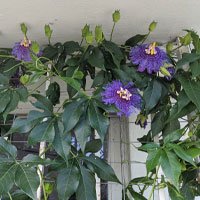
With its awe-inspiring flowers, abundant foliage, and mountains of cultural background, the Purple Passionflower (Passiflora incarnata) can certainly be considered a true botanical marvel. Belonging to North America, it is a climbing perennial, attracting our attention by prominent flowers of dark lavender colour, topped with corona of filaments and gently felted petals. Besides its mere aesthetic value, Purple Passionflower is highly sought-after for its various medicinal and culinary uses. It is pleasing to the eyes and at the same time it is very useful for the garden. It is by no way insignificant that the incredible vigor and endurance of Purple Passionflower attracts awe and discovery for those who are willing to marvel and wander and consequently enjoy the artwork that is the splendor of a greenhouse.
Majestic Features of Purple Passionflower:
Exotic Blooms:
- The unmatched esthetic value of the Purple Passionflower has been attested to with the abundance of diverse colors comprising its crest of petals, sepals, and filaments. Those include purple, white hues and more.
- The fragile flower that reminds you of the stars shapes up as many small petals, a coronet dazzling royalty.
Cultural Significance:
- If you find a shaman or a Native American, you will discover huge respect of Plant become as the plant-symbol of their spirituality, transformation, and resilience.
- The ethereal beauty and intense aroma it offers have inspired fantastical stories, created artistic works, and penned literary pieces. Myths, tales, legends, arts and writings which weave the pieces together and embellish cultures that is remarkable.
Medicinal Properties:
- Purple Passionflower may be claimed to have medicinal qualities and extracts from its leaves and flowers are the active ingredient in conventional herbal tinctures to soothe and calm nerves.
- Its soothing effect leads to the discovery of an amazing ally in herbal medicine. It gives comfort to anxiety or sleeplessness.
Ecological Benefits:
- As a host plant of different butterflies species, purple passionflower garden is indeed a provider of pollinators with the necessary environmental support of biodiversity in the garden ecosystem.
- By possessing particularly sweet nectar, the assorted insects from bees, hummingbirds to butterflies will visit for nectar provisioning. This translates to an increased community of diverse species including natural pests managed and hence increased garden biodiversity.
Edible Fruits:
- Passionflower with purple flowers gives rise to small, egg-shaped maypops with a yellow color when mature and ripe. They can be eaten when completely ripened.
- The fleshes are sweeter than tarter and can either be eaten freshly or made into jams, jellies and deserts while injecting a flavor of the tropics.
User-Friendly Features of Purple Passionflowe:
Easy to Grow:
- Purple honeysuckle is a simple flower to cultivate which will do through well-drained soil and in sunny weather.
- This variety has a strongly upright growth form and high drought resistance attributes, making it suitable for cultivation in diverse climates, ranging from areas with moderate to tropical temperatures.
Low Maintenance:
- After successful establishment, Purple Passionflower requires little maintenance apart from pruning to guide growth and give option for shaping as you desire.
- Its flexibility to various soils and growing conditions makes it a handy didn’t fuss item in garden parks.
Fast Growth:
- The Purple Passionflower gains popularity for its quick growth speed, making trellises, arbors and fences be covered with its twining vines before you know it.
- Not only does its speedy growth gives it a necessity for use as a growing screen, that is, for obtaining privacy and shade outside at a go.
Self-Seeding:
- Purple Passionflower could self-seed and naturalized under very favorable conditions (for instance: adequate light and water), thus dispersing their irresistible colors among the garden.
- It requires that the existing offspring needs to be pulled out once in while in order not to occupy an overcrowded space, yet ensure their chances of survival, thus a continuous supply of new plants.
Long Blooming Period:
- Purple Passionflower prolongs its blooming time from late spring up to early fall, as opposed to blooms, which are seen only in a short period between late spring and summer.
- The prolongation of the period of opening flowers makes it possible to provide the pollinators with a constant supply of nectar and more than fantasy of the admirers with colors and shapes of flowers.
Irritating Features of Purple Passionflower:
Invasive Potential:
- In certain areas, purple Passionflower will be a highly invasive species as it will assert its growing ability very fast and might engender the extinction of native vegetation in the process.
- Gardeners must constantly be aware of the declared potential for growth and require some kind of measure to stop the invasive spread in natural environments.
Potential for Overcrowding:
- Because of its fast-paced growth, Passionflowers of the color purple will sometimes fill the entire garden bed where they are planted making it necessary to do regular thinning to ensure the plants stay healthy and well-looking as well as to gratify the decorative tastes of gardeners.
- Optimal spacing and accurate positioning are the key to preventing the neighboring plants from competing for the same resources.
Spreading by Runners:
- The Purple Passionflower creeps along the soil, sending its new shoots outwards, and it is entirely possible that they will take over the adjacent region.
- As a long-term measure of caution, the containment of its spread and avoidance of overrunning other garden plants or structures should be emphasized.
Allergenic Potential:
- Some people might suffer from skin irritation when their skin is in contact with the sap or the foliage of Purple Passionflower. Others may get redness and allergic reactions when they get in touch with its stalk or flowers or the nearest part to them.
- Chemical or biological sensitivity when working nearby or with them is something you should be aware of particularly if you are one with sensitive skin.
Fertility Requirements:
- It might be necessary to push purple passionflower fertilization to keep vigorous growth and abundant blossoming, especially on soils with lower nutrient value.
- The right blend of balanced fertilizer used as a supplemental addition will help ensure that the performance is optimal, and the plant shape is sound.
Conclusion:
In a nutshell, Purple Passionflower is such an outstanding plant with its gorgeous blooms, rich culture, and favorable ecological attributes that make it readily fit into one’s garden area. Whilst its invasive quality and rapid growth make its management complex, naturalizing it is easy due to the multiple positive contributions such as medicinal properties, and attracting wildlife. Through this knowledge, gardening becomes the process of cultivating a beautiful tapestry of hues and diversity, as each environment is a unique venture. And possibly, a very captivating one. Let us honor its botanical treasures and avail ourselves of our potential to make various outdoor spaces outscoring in mystery and dynamism.
Purple Queen (Setcreasea pallida):
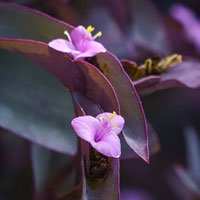
Setcreasea pallida (Purple Queen) adheres as a horticultural gem which draws the attention of gardeners as it produces purple-colored leaves and hues with an outstanding hue. Native to Mexico, this perennial groundcover that is resilient is perfect for adding a touch of aristocratic rareness to your garden landscaping because of the cascading vines and dense carpet of bright leaves. This Purple Queen variety is highly flexible in different growing environments and easy to grow and care for; therefore, it surely makes your garden the most attractive and colorful one. Following that, we shall disclose the bounty of its features both from the user-friendly and on the contrary, somewhat frustrating perspective to unveil the fantasy and allure of this mystery plant to you.
Majestic Features of Purple Queen:
Stunning Foliage:
- The lavender leaves of Purple Painted are shaped like a lance and are dark purple in color which gives the plants a majestic look in the garden and border beds.
- The rich hues may intensify in full sunlight, making the butterfly bring a sharp contrast against the greenery and other companions in the flowers.
Graceful Growth Habit:
- Along with its tufting stems, Purple Queen will form a mass of foliage, spiraling elegantly down from walls, pots, or even rocky settings.
- Its upright growth habit, with royal blue flowers tumbling like a luxuriant carpet of color, brings vertical interest to different types of gardens.
Drought Tolerance:
- Purple Queen can easily adapt to drought conditions once planted and thus, is suitable as part of the xeriscaping and water wise gardening.
- The drought tolerance ability leads to saving water since it requires less irrigation, which in the end supports sustainable development.
Long-lasting Color:
- The wondrous purple foliage of Dame Purple Queen do not lose its color during the whole planting period and hence provide green space with permanent interest.
- Even in areas where temperatures drop below freezing point, one can still find foliages of different colors, such as burgundy and golden brown, that create illumination and warmth in the winter landscapes.
Wildlife Attraction:
- The small flowers of a Purple Queen plant, though not eye-catching, draw the attention of natural pollinators like bees and butterflies. Hence, biodiversity is increased in the garden.
- This foliage is also habitat for great numbers of useful insects including predators, keeping the ecosystem balanced.
User-Friendly Features of Purple Queen:
Easy Propagation:
- Stem Cuttings can be used as a way of multiplication and fresh propagation for Purple Queen in water or moist soil.
- Its quick maturation and ease of resurgence in diverse growing environments soon make it the most preferred plant variety by both novice and seasoned gardeners.
Low Maintenance:
- Following the planting, Purple Queen typically requires no extra input from you except for the minor task of pruning to retain the most desirable shape.
- It provides insects and diseases with less chances of affecting the Plants hence either these are not required or required only in the way chemical interventions are promoted in a healthier garden environment.
Versatile Uses:
- Purple Queen is a tough performer of a plant that can be used as a coating groundcover, a trailing element of container and filler in mixed border.
- Its flexible characteristic will allow its planting in either sunny or shadow region, thus giving trees and shrubs a chance to be set up in various garden settings.
Deer Resistance:
- Because of its deer resistance Purple Queen is a good choice as a landscaping bush in the areas of land at risk of grazing by browse animals.
- The barely edible leaf slims off creatures like deer to prevent their foliage of garden plants that maybe be eaten.
Indoor Adaptability:
- This variety can be used as a houseplant that will add vividness (or liveliness) to the interiors as well as hanging plants with its pretty foliage.
- Its tolerability to the low light environment converts it into a perfect fit for office settings, insulated flats, and others internal spaces with restricted sunlight supply.
Irritating Features of Purple Queen:
Invasive Potential:
- In favourable conditions for growing, the single fast-growing and naturalizing Purple Queen species can easily overtake the local native vegetation.
- The presence of genetically modified genes in wild evolution may take place, which might result in uncontrollable outlandish growth in natural habitats.
Sensitivity to Frost:
- Purple Queen is tolerant to low temperatures but can be affected by frost and freezing, especially in colder climates meaning that you will have to take measures to protect it like bringing it indoors during winter.
- Where it is case of severe winters, it can behave as annual or a container plant to enable its survivability.
Overcrowding:
- Purple Queen’s vegetative vigor can be a double-edge sword subsequently creating a well-kept or unkempt garden and border, while thinning can only help it.
- It is vital to provide right spacing as well as placing the neighbors plants with some reasonable distance for unhindered access to the needed resources.
Allelopathic Effects:
- Some studies propose that it is possible that the whole purple expression is able to generate phytochemicals that stop the development of neighboring plants.
- This character may appeal to crowd control in the planting of weeds but may also complicate the application of the companion planting and intercropping strategies.
Limited Flowering:
- The decision to harvest Purple Queen in summer or fall depends upon the speed at which pollination occurs. While this variety may produce small pink or purple flowers here and there during the growing season, generally its ornamental property lies in its foliage.
- Gardeners who wish for many blossoms may get a little dismayed by the scratchy blooms when the compare the flowering ground cover with other varieties.
Conclusion:
In essence, Purple Queen (Setcreasea pallida) is a powerfully adaptable plant fancied for its easygoing nature, colorful leaves, and adorable braiding pattern. However, its invasive nature, frost resistance and as well as its negligible maintenance might require a thorough assessment to ensure a suitable location would be chosen. Nevertheless, an attractive addition to the landscape gets all plus marks since it acts as a food source for wildlife. Gardening enthusiastically not only makes use of the major positive aspects but also tries to solve some challenges like this, gardeners can create a masterpiece of colorful and textural pattern in their outdoor space, which provides them the ultimate opportunity to experience the state of harmony and richness of biodiversity. Let us honor Purple Queen for its everlasting charms and turn beautiful gardens into places where you feel thrilled for your eyes and your patched soul.
Clematis ‘Niobe’:
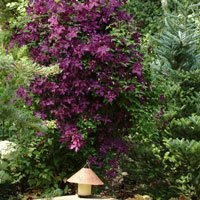
Clematis Niobe is considered to be an extraordinary climbing vine with its remarkable, burgundy-colored flowers. Its vigorous growth is a very impressive sight. The ‘Niobe’ genus, which is part of Clematis, is a floriferous and adaptable variety that has the power to spice gardens with elegance and novelty. It is very flexible for garden design. These bushes are the result of an involvement of hybridization, which feature rich coloration in addition to ability to thrive in a variety of climate and soil conditions, an element that it makes them fellow come first choice for trellises, arbors, and fences.
Majestic Features of Clematis ‘Niobe’:
- Burgundy-Red Blooms: Members of Clematis genus ‘Niobe are obviously the ones that present in your garden the large flowers that make a real statement.
- Abundant Flowering: The vine is decorated with such a myriad of bright-colored flowers from late spring to early summer. It seems like a cascade braided by blossomed vines.
- Vertical Impact: The vine consumer behavior that ‘Niobe’ offers is unmatchable. By very easily climbing trellises and arbors, it quickly gives your garden design a vertical interest and structure that is unparalleled.
- Long Blooming Period: The ‘Niobe’ cultivar showcases its value with its long flowering duration. It will be giving the extra chance to admire its beautiful colors and beauty for every period of the growing season.
- Pollinator Attraction: Beautiful flowers of ‘Niobe’ are responsible for stimulation of actual garden diversity as pollinators like bees and butterflies take part in this process.
User-Friendly Features of Clematis ‘Niobe’:
- Adaptability: ‘Clematis’ Niobe’ variety can grow in different soil types and conditions, doing well in organic-rich soils with sunny spots.
- Low Maintenance: Initial setting and ‘Niobe’ care consists of regular watering and gentle pruning to keep its growth in place and stimulate flowering.(which are the only basic things needed to keep the plant alive).
- Container Gardening: this plant can be grown in pots outside which it makes it convenient to either put it on the balconies and patios or even for those who do not have space in the main garden.
- Winter Hardiness: Its good winter hardiness performance makes it the cool season variety is good is also suitable for more temperate climate where the temperatures fall below 0 Celsius.
- Disease Resistance: ‘Niobe’ stands out from Clematis diseases like Clematis wilt, and therefore, the rate of the plants affected by fungal diseases is reduced.
Irritating Features of Clematis ‘Niobe’:
- Pruning Challenges: There is a high chance that Clematis ‘Niobe’ will need certain pruning techniques for it to produce flowers and to keep the plant healthy and strong, which are not a favorite of gardeners who are just starting.
- Susceptibility to Drought: In areas with a hot and dry climate, Niobe may be vulnerable to moisture loss which in turn limits blooming and flowering. Therefore, a delicate balance has to be maintained when watering these crops.
- Slow Establishment: First of all, to build Niobe’s reputation in the orchard, the first years are dedicated to observing and focusing on the establishment.
- Potential for Overcrowding: Absence of proper care and pruning will result in vines becoming intertwined and overcrowded, while not underneath their full potential.
- Invasive Tendencies: In some areas of the country, the spread of ‘Niobe’ could be alarming, as it may rapidly spread and favorably compete with native vegetation if no management is taken.
Conclusion:
To summarize, the Clematis ‘Niobe’ is not a simple flower, but, rather, a wonderfully compatible garden embellishment, resplendent with deep maroon-red blossoms and a generously opportunistic climbable habit. Despite its being a water-hungry species, having to prune from time to time and a drought susceptibility, it is still a versatile plant with few demand for maintenance requirements, and attracting for pollinators that makes it an appreciated plant in gardening. Embracing of its merits along with the downsides resolution, gardeners can create the fabric of nature made up of green, flowery, and much more are immersing visitors in ecological fairy tales. Let us not lose this easiness arousing of ‘Niobe’ and exploit her to design those gardens and parks that make us conscious of our bodies and help us to recover our spirit.
Akebia quinata
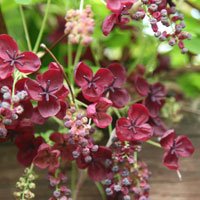
Akebia quinata, a popular and much-admired climbing plant that belongs to the genus Akebia is a beautiful Perennial which is known as Chocolate Vine or Five-leaf Akebia for its flowering proficiency and show-stopper green leaves that come to the spotlight in the summer. Originating in East Asia, the woody climber endows the landscape of gardens with its dark, luxuriant foliage, and groups of flowers that hang downward and generally appear of the purplish-brown colour, fragranced with sweet chocolate reminiscences. The Akebia quinata’s fast-paced adaptation to different growing circumstances and relative ease of cultivation is one of its most striking qualities that make gardeners consider it a favorite choice which would give their outdoor designs a unique and tasteful touch.
Majestic Features of Akebia quinata:
Fragrant Flowers:
- The Purple Wisteria blooms in clusters of small, pretty bell-shaped flowers, with a pleasant chocolate scent, which is a general attraction to pollinators as well as a tempting factor to the eyes and nose of people.
- Once early spring arrives, the garden furniture acquires its signature scent of blooming flowers that characterize the season through these sweet-smelling plants.
Ornamental Foliage:
- The leaf arrangement of Akebia quinata consists of five leaflets of a palmate pattern, the lively green display being the major scene in the flower of the plant.
- The same shiny leaf trees go various stages of yellowish brown and purple and also is seasonal interesting as the time passes.
Rapid Growth:
- Akebia occurs fast and tries to sidestep with its twining stems any trellises, arches, or fences.
- Instead of age, its rapid dynamics enable trimming the privacy, unwanted views in the garden.
Edible Fruit:
- After the aggregate flowers of Akebia quinata, the plant gives rise to sausage-form long fruits that are distinct and convey a taste that is like that of the tropical fruits.
- The tasty berries despite the fact that they are little grown as consumption fruit, partake in the beauty of the vine adding uniqueness .
Wildlife Attraction:
- The flowers of Akebia quinata add variety to garden diversity and river flora while simultaneously helping pollinators like bees and butterflies to thrive.
- This in turn creates the sense of comfort and safety for small birds and other wild creatures.
User-Friendly Features of Akebia quinata:
Easy to Grow:
- Akebia quinata is considered as a very simple plant to grow, as it is completely comfortable in well-drained soil and partial to full sunlight.
- It has the pliability that makes it look beautiful in gardens of all kinds, including those in city landscapes and country retreats.
Low Maintenance:
- The tree can invariably be grown without much effort, pruning might be required from time to time if the growth is quite much or if the desired shape is not maintained.
- It possesses an innate ability to fight bugs and diseases hence it is viewed as a solution that reduces the use of chemicals, and therefore, improves the health of garden environment.
Drought Tolerance:
- Established akebia quinata master’s a chance for drought tolerance which is highly preferable in the water-wise landscaping.
- Most importantly, it has drought resistance, which means that it grows in dry conditions. This, in turn, means an uninterrupted water supply to the plants.
Deer Resistance:
- Akebia quinata has only a limited appeal to the deer, therefore, making it a good option for the landscape that is often visited by the browsing wildlife.
- It is sour-tasting, and this strongly repels deer and other herbivores away from the garden, thus leaving the plants in the garden safe from unsolicited damage.
Versatile Uses:
- Akebia vine can be trained to climb trellises, arbors, and pergolas, so garden structures get decorated by its long, wavy leaves.
- This plant’s beautiful cascading habit meanwhile gives variety for hanging baskets and container gardening that renders a one-of-a-kind accent to terraces and balconies.
Irritating Features of Akebia quinata:
Invasive Potential:
- The Akebia quinata species, being native to some areas, may demonstrate invasive behavior, spreading fast and outcompeting the native vegetation.
- Gardeners need to take care of the particularly escalating extension of weed and make some effort to keep it from spreading in the natural space.
Pruning Challenges:
- Akebia quinata’s fast growth and climbing woody vine are often in demand of regular pruning which will discourage it from growing beyond the desired limit and from overgrown situation.
- Maintenance is not something that can be ignored, the vine may become messy and that is difficulty to handle in the case of you not having maintenance.
Potential for Damage:
- Akebia quinata’s soft stems may grab and attach themselves to surrounding objects using adhesive pads which is a danger to them, thereby posing a risk for damage to walls, fences, and other garden features.
- Careful watching and training may be necessary to keep structural damage and to let the plant tied down tightly to reach the desired area of growth.
Spreading by Seed:
- The akebia quinata can produce seeds that can travel and get naturalized when the growing conditions are favorable; this could evolve them to invasive species.
- By keeping spent flowers and fruits removed periodically the random seed panicles will be restricted, and this will keep the creep of the vine under control.
Overcrowding:
- As Akebia quinata grows really rapidly, there might be the case of overcrowding in flower beds and borders. Therefore, one needs to thin the plants regularly in order to secure good health and also the required beauty.
- Inadequate spacing, and/or making sure plants are placed in optimal positions will solve competition for light, water, and nutrients between plants in the neighborhood.
Conclusion:
To sum up, Akebia quinata, or Chocolate Vine is a wonderful decorative plant, ideal for a garden due to its fragrant flowers as well as edible fruit. Although its quick growth and invading characteristics pose difficulty levels, it is backgrounding oneself with its capability of growing in different conditions, ease of gardening and attraction of wildlife that make it a valuable part of landscaping gardens. Through appreciating its merits and finding solutions to its shortcomings, gardeners can offer their backyard a green and noisy venue which is a true host for environmental creatures. Now, let us celebrate the individual beauty of Akebia quinata as well as its potential for using it, especially in gardens with a delight for all senses and the soul!
Clytostoma callistegioides:
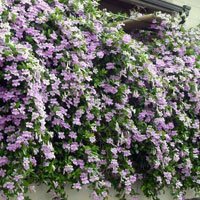
Clytostoma callistegioides, the popular name of which is the Argentine Trumpet Vine or Violet Trumpet Vine, is an unforgettable flowering vine with long, pointed and trumpet-shaped flowers that grow in clusters and bunches of foliage. Originally from South America, it is a succulent climber that can introduce a subtle Latin flavor into garden spaces with its jungle-like jungle-print and swiftness in growth. Featuring its multi-purposefulness for different growing conditions and ease of cultivation, Clytostoma callistegioides is one step closer to turning outside spaces into a masterpiece of beauty and identity.
Majestic Features of Clytostoma callistegioides:
Spectacular Flowers:
- Clytostoma callistegioides has flowers measuring up to 28 cm in length, brightly colored violet or lavender flowers, or any shade of pink flowers, which provides a vivid view of the slopes with its blooms.
- Bee, butterfly, and hummingbird friendly, the dazzling flowers spring forth in clusters on canes throughout the vines for a fanciful picture in the garden.
Abundant Bloom:
- The Argentine Trumpet Vine weaves in and out between stems from springtime right into summer and covers the vine in a blow of bright color.
- The heart of this British flower is its ability to prolong its blooming period making it a joy both to garden and flower pollinators.
Luxuriant Foliage:
- Lush, dark green leaves of Clytostoma callistegioides are thought to be a great focal point for this plant, covered with the species’ colorful flowers.
- Sassy leaves are extra, not just touch but even an eye rest. They add character to the vine and make it even more appealing to look at.
Rapid Growth:
- With its fast vigorous habit, this trellis, arbor, and fence climber covers openings in the setting with verdurous drapes of foliage and flowers.
- In addition to sheltering, this vegetation can also be used for filtering the sunlight or something extending into the sky.
Tolerance to Heat:
- The Argentine Trumpet Vine has high-temperature and low-rainfall tolerance characteristic once it is established which makes it an excellent choice for inclusion in warm climate.
- Thanks to its remarkable capability of growing under hot and direct sun conditions, the plant becomes even more appealing as an element of a low-on-maintenance landscape.
User-Friendly Features of Clytostoma callistegioides:
Easy to Grow:
- Clytostoma callistegioides is an easy-to-grow plant similar to other orchids which requires great drainage, and full sunlight.
- The ability to grow tomatoes in a wide range of soils and conditions of the increasing population and the organically produced them makes them a good choice for both newbies and skilled lovers.
Low Maintenance:
- When set up, Argentine Trumpet Vine does not require much of care at all, thereby necessitating a little pruning time to time so that one can maintain desired shape and size.
- Resistant to pests and disease its application decreased the use of toxic chemicals creating a habitat for a healthier environment.
Versatile Uses:
- Clytostoma callistegioides can be trained to double as accents for trellises, arbors, and pergolas, providing additional dimension into your garden structures.
- Because of that cascade effect, it is such a great choice for home gardening as well as for hanging baskets and container gardening to accent patios and balconies with an impressive focal point.
Attracts Pollinators:
- The bee-pollinated species of incredible Argentine Trumpet Vine is nourished not only by bees but also butterflies and hummingbirds as its flower nectar stems.
- Being a native species and a host plant for many pollinators while still being a beautiful blooming specimen in the garden helps to increase the biodiversity and overall health of gardens as well as the ecosystem.
Longevity:
- Clytostoma callistegioides is a great perennial vine which is characterized by its long lifespan, allowing for months of garden landscape beauty and pleasure to be enjoyed.
- Its lasting colors render it a significant part of the use of the outdoor living quarters throughout the seasons.
Irritating Features of Clytostoma callistegioides:
Invasive Potential:
- In mild climate areas, Clytostoma callistegioides be more aggressive rather than reduced to a single location by spreading out quickly and taking advantage of natives vegetation.
- One must be cognizant of its probing growth and acts to counteract uncontrolled expansion in natural habitat to protect it.
Pruning Challenges:
- The rapid progression with a twining stem may necessitate pruning at regular intervals to limit its size and to solve the weeding problem.
- In case the thicket is not regularized, the shape may become chaotic and therefore difficult to control.
Potential for Damage:
- Clytostoma callistegioides, a plant that twines about, can attach itself with sticky pads to the walls, fences, and other garden elements leading to deterioration of structures.
- We could do some monitoring and training focusing on controlling the plant’s structures in case of any harmful side effects or to keep the plant growth under control.
Sensitivity to Frost:
- Wintering of Argentine Trumpet Vine during cooler periods necessitates either sheltered protection or overwintering in indoor regions with colder climate.
- In regions with extreme winters, it gravitates towards behaving as an annual and when grown in a container it ensures better endurance.
Spreading by Seed:
- Clytostoma callistegioides discharge seeds that are capable of spreading and naturalizing in the best suitable growing environment, and in this happens, it might be regarded as invasive.
- A routine procedure of taking down the spent flowers and fruits is believed to prevent the process of seeding and thus, will be another means with which one can take control of the vine’s growth.
Conclusion:
In a nutshell, Clytostoma callistegioides, better known as the Brazilian Trumpet Vine, sets itself apart in the realm of garden landscapes with its brightly colored flowers, casual shading of foliage, and fast-paced growth rate. Its invasive nature as well as frosty resistance have only limited applications, but its adaptability, simplicity, and wildlife attracting make it a valuable property for horticulture. Gardening can be an excellent opportunity to regulate the negatives and amplify the positives of each color – this way, your garden will become a wonderful landscape of charm and diversity filled with abundance of living colors. Let’s use Clytostoma callistegioides in the same way to create pleasing garden landscapes that make you explore the beauty of nature with all your senses and feed your soul.
Lathyrus odoratus ‘Black Knight’:
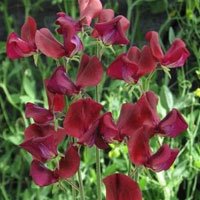
Lathyrus odoratus ‘Black Knight’, a plant belonging to the Sweet Pea family, is renowned for its widest black, velvety blooms and enchanting scent. This version of the sweet pea is indigenous to the Mediterranean region where it is known for its grace and regal looks in addition to being the measurement of beauty. Fast growing and having lovely flowers, ‘Black Knight’ rose is the embodiment of captivation on the part of gardeners and aesthetes alike. It offers a treat for the senses with its beauty and fragrance and makes the garden and any outdoor space more beautiful with its on-look.
Majestic Features of Lathyrus odoratus ‘Black Knight’:
Dark Velvety Blooms:
- ‘Black Knight’, the variety with flowers of deep purple, almost black tone, and a velvety texture, resembles an eye-catchy pattern against the beautiful green of the foliage.
- The bright colors and distinctive shapes present the flowers with an air of mystery that can spruce up the edge of the garden border, gardens in the pots and the fences.
Sweet Fragrance:
- The flowers of ‘Black Knight’ exhale a honey-like and spicy scent such as honey and spicy so as to attract pollinating bugs and people alike.
- The chunky scent is soaked in all over, it doesn’t need to be blasted in the air for a creation of an atmosphere of enticing of this garden.
Long Stems for Cutting:
- ‘Black Knight,’ is a variety which offers rusty thick stems that are perfect for cutting so it has great demand among florists for making bouquets or arrangements.
- Among the advantages is the fact that there is lots of bloom, and these flowers produce them for a longer period of time and as such they are continually available to beautify the inside of our dwellings.
Prolific Blooming:
- Cultured and went without the shadows, the ‘Black Knight’ appears successful and prolific through the vine in spring until the early summer and unraveling from it a parasol of blooms.
- This flamboyant blossoming will provide a visual treat and far-reaching aroma, that will make the garden a refreshing place to spend time in all the time.
Attracts Pollinators:
- ‘Black knight’s flower, thanks to its exciting scent, is attractive to bees, butterflies, and hummingbirds pollinators, keep up the garden biodiversity.
- When developing my planting plan, I would like to make sure that ecosystem preservation is one of my priorities since bees are pollinators which leads to natural pest control in the garden.
User-Friendly Features of Lathyrus odoratus ‘Black Knight’:
Easy to Grow:
- Lathyrus odoratus ‘Black Knight’ seem to be a good choice for cultivation. They require to grow on well-drained soil with access to full sun.
- Its capacity to be deployed in a variety of soil and atmospheric conditions has earned it of the credibility of beginners and veterans alike in the gardeners field.
Low Maintenance:
- The array of benefits of ‘Black Knight’ makes it stand out among the multifunctional, low-maintenance blooms that thrive with just watering and fertilization at moderate intervals.
- Its ability to live a pest and disease-resistant life without the need for chemicals is considered a positive measure and is directly linked to the general good health of the garden.
Versatile Uses:
- ‘Black Knight’ is a good choice to be cultivated for climbing trellises, arbors, and fences, making garden structures become more interesting.
- The multiple cascading growth nature of the plant makes it a great choice for hanging baskets as well as container gardening arrangements; hence, it would provide a stunning display on the patios and balconies overlooking the greenery.
Tolerant of Cool Weather:
- ‘Black Knight’ flowers are considered heat tolerant, extending the growing season for spring planting and flowering into the cold weather into fall.
- With its cunning coming into its own in both cold and hot weather climates, it is always present to rev up the bloom season.
Long-lasting Cut Flowers:
- Long-lasting flowers can be achieved by following several care suggestions as the Black Knight’s flowers sport a lovely shade of black and exude a pleasant fragrance for many days after they are cut.
- Gardeners can enjoy the color and perfume of the ‘Black Knight’ flowers on the inside, manifesting a simple element of sophistication in any bedroom.
Irritating Features of Lathyrus odoratus ‘Black Knight’:
Limited Heat Tolerance:
- ‘Black Knights’ are very likely to have poor flowering performance if temperatures are above the normal range and humidity is high, which necessitate additional attention and protection from direct sunlight at its intense strength.
- In warm regions, gardeners may have to one, shade or, two, bring extra amount of water to create a therapeutic environment away from the heat effect.
Prone to Powdery Mildew:
- In humid conditions hairy-locks bane can be attacked by powdery mildew, a fungal disease that can impact the leaves and blooms.
- Routine checking and timely application of fungicides will be carried out to interrupt and ameliorate powdered mildew.
Tangled Growth:
- Windy stems of to a city and need regular brushing or trimming to remain neat and fashionable.
- Without proper pruning and care to guide the vine’s growth on arches or trellises, it may attack such structures and become difficult to handle.
Short-lived Blooms:
- Each bloom of “Black Knight” lasts for just a couple of days. The blossoms go to ground and fade away.
- Deadheading flaccid flowers which are no more in bloom can also help extend the flowering period of a plant and encourage fruit formation.
Invasive Potential:
- In areas with mild climate ‘Black Knight’ with its elitism (to use fewer resources) might be a good solution, where it can self-seed, spread and grow fast in good conditions.
- However, the unique factor that sets this plant apart is its tendency to take over even in an indistinctive setting and it is important to be mindful of this and restrict its proliferation.
Conclusion:
‘Black Knight,’ the star of the Lathyrus odoratus family, is stunning and easy to manage, with allurements of dark liquor velvet blossoms, sweet ham type, and various applications. However, its limited heat tolerance and susceptibility to powdery mildew might cause some difficulties, as its versatility, ease of maintenance and the fact that it is a beloved gem among pollinators make it the privileged plant in the horticulture realm. The morality of using pesticides can be highly debated — benefits like insect control and less plant damage are satisfied, while various drawbacks such as endowment risk and insecticide’s impact on environment and human health might be raised. Here is to our celebration that never wanes as ‘Black Knight’ goes on its true nature building beautiful garden scenery that tickles your senses while feeding your soul.
Vitis vinifera ‘Purpurea’:
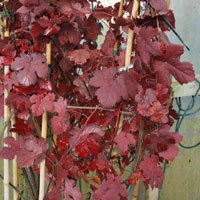
The ‘Purpurea’ cultivar of the species Vitis vinifera is known to everyone as the Purpurea Grapevine or Purple Leaf Grapevine – it is a beautiful ornamental vine with exceptional purple foliage and an elegant appearance. This type of Vitis vinifera, from the Mediterranean region, creates a sense of delicacy and poise in the garden where its dark purple leaves and vigorous growth habit are admired. While mainly cultivated for the beauty it brings together with its small but sweet berries, this variety adds a bit of usefulness to its ornamental character. Nobody can deny that this great variety can be easily implemented in different conditions for growing and is it does not demand special or professional knowledge this grapevine is able to turn any outdoors space into a decoration of colors and patterns.
Majestic Features of Vitis vinifera ‘Purpurea’:
Striking Purple Foliage:
- The variety of Purpurea Grapevine demonstrates vivid foliage in the tone of purple which contributes to the dramatic and color-rich garden landscapes.
- As sunlight increases, the color of the foliage gets darker thereby providing a dramatic contrast with the rest of the environment, ensuring that visitors get treatment for their eyes.
Ornamental Value:
- More than just the fruiting capacity, ‘Purpurea’ Grapevine is famous for its ornamental value, offering a multi-dimensional aspect to landscaping through adding the dimension of a plant that brings texture and height to man-made structures .
- Vine’s many stems which are twining, and its beautiful foliage make it the perfect plant for arbors, trellises, and pergolas.
Edible Grapes:
- Whist the main purpose of this plant is its colorful foliage, ‘Purpurea’ Grapevine also yields small, grapes apt for eating fresh and will make a good jelly and wine.
- This creates the advantage of vine which twines its way and climbs the plants in an attractive and useful way in the garden landscaping.
Seasonal Interest:
- beyond its decorative presence the other property of this type of grape vine is the fruit that enlivens its foliage with plenty of small, scented blooms in spring and summer.
- The exquisite flowers tend to attract bees and other insects sustaining the life-cycle of other plants while the appearance seems eye-pleasing for the whole environment.
Wildlife Habitat:
- The tightly compacted foliage of the grape variety ‘Purpurea’ that is considered as a large shade canopy for birds. That ultimately increases the biodiversity and health of the ecosystem.
- The grape’s fruit provides habitat for animals like birds and small mammals in addition to simply acting as a food source. It does so by making the vine more attractive to them, thereby providing another ecological value.
User-Friendly Features of Vitis vinifera ‘Purpurea’:
Easy to Grow:
- ‘Purpurea’ of Vitis vinifera is considered to be rather hardy, this refers to the conditions of well-drained soil that allows it in excess of excitement and sun to grow bigger.
- On account of its flexibility to multiple soil types and growing conditions, growers ranging from novice to professional may all find the species to be enjoyable to plant.
Low Maintenance:
- And the existing ‘Purpurea’ Grapevine vine hardly demands any maintenance, only some pruning work done at intervals to regulate the growth and to retain the natural form.
- As resistant it is to pests and diseases, such chemical usage is not needed in comparison with a natural garden. Consequently, a healthier garden environment is only seconds away.
Drought Tolerance:
- ‘Purpurea’ Grapevine swiftly displays fantastic drought resistance once it gets settled, thereby qualifying it as a good option for water-conserving landscaping.
- The plant’s resilience in dry areas implies reduced water intake hence using of water resources conserves the same.
Vigorous Growth:
- Celebrating the fast-growing characteristic that ‘Purpurea’ Grapevine displays, it can quickly cover pergolas, trellises, and fence-shapes in gardens creating privacy and shade in garden landscapes.
- Because of its fast spread, moss is an ideal option for living screens and green walls which enhance the surroundings.
Longevity:
- Vitis vinifera ‘Purpurea’ is a perennial vine, often growing for years, giving the garden with ornamental value such as beauty and pleasure.
- Its durability is the main feature reliable one for the destination of the future in the outdoor spaces till the season arrives.
Irritating Features of Vitis vinifera ‘Purpurea’:
Invasive Potential:
- In the regions of warm climates, Vitis vinifera ‘Purpurea’ may have a character of invasive phenotype, overgrowing fast and competing native vegetation.
- The gardeners should be vigilant with its close neighboring localities to avoid any harmful threats to nature.
Pruning Challenges:
- The self-climbing nature of ‘Purpurea’ Grapevine often require the growers to be pruning it regularly to restrict its huge growth and from taking over other plants.
- Vine will turn irregular and uncontrollable if no regular check-ups are done, especially, when it is the case of structures like trellises and arbors.
Potential for Damage:
- ‘Purpurea’ species of Grapevine grow with the twining of the stem that can attach itself to adjacent structures with the help of adhesive pads and putting at the risk of the damage to walls, fences, and the other parts of garden.
- Regular checkups and plant rehabilitation measures may become necessary in order to avoid resistance to the structure and keep the plant growing in the scheme of things.
Self-Seeding:
- Vitis vinifera ‘Purpurea’, recently proved popular for the property of self-seeding, may grow naturalized condition that can quickly cover the surrounding with foliage and so becoming invasive.
- For instance, a periodical removal of the growing seedlings will certainly stop the spread of vine and handle its growth perfectly.
Messy Fruit Drop:
- When Purpurea cultivars mature, the tiny berries can even fall to the ground and become bothersome to guard the pathways and flowerbeds.
- An appropriate amount of harvesting and cleanup of the fruit residue may be required to prevent litter and to keep the garden area clear.
Conclusion:
In summary, though it is truly an impressive and easy to handle grape kind, Vitis vinifera ‘Purpurea’ or Purpurea Grapevine, has both graceful purple leaves and edible grapes, and an energetic growth. Though, in a long run, it has rather negative traits, like its invasive potentiality and it being a demanding plant to grow, its adaptability, elegant beauty, and wildlife lovers’ delight are the factors, that, mostly likely, will long keep it in the horticulturists’ repertoire. Gardening blossoms through its praises and could correct the weaknesses, gardeners thus are able to construct a prospering patchwork of flowers and texture that can convert the outdoor spaces to everyday enchantments and sites of rich and diverse beauty. Here, we applaud ‘Purpurea’ Grapevine for its continuing effect on appealing garden settings, where through careful selection, it can form the much-needed backdrop for creating landscapes that thrill our senses and satisfy our soul.
Grand Conclusion:
Thus, the world of the vine purple leaf plants is an amazing area where aesthetics, diversity and mysterious union play their part to build spellbinding handiwork of Gardenscapes. Whether is the awe-inspiring trellis with its lovely foliage or the straightforward varieties which simply grow with simple care, the colorful, exquisite array of shades and textures that these plants offer is exciting enough to rejuvenate our minds and soul. Even though every now and then the plant gets it in the neck when its aggressive behavior goes beyond the borders or you have to trim it, raising these cultivars becomes very enjoyable and overrides any irritation. Thus, I urge you to celebrate the multifaceted beauty of purple vine plants by joining a riveting experience that is filled with curiosity and limitless opportunities, and in the process, leave a strong impression in your guests’ memories when you go into the process of designing excellently.

